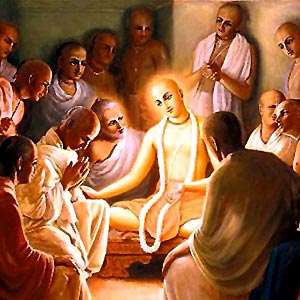 Tantrism in Bengal attributes its origin to the revival of the Brahmanical religion during the post-Pala period under the Senas of Vaishnavite and Shaivite persuasions. After the Sena dynasty was overpowered, Hinduism suffered to a great extent. However did not disappear despite the onslaughts of hostile people and unfavorable conditions. Religion of Hinduism assumed new attire and was revitalized by Chaitanya. He brought home the utter hollowness of rigid rites and customs without self-purification and love of humanity. The flood of devotion-cum-love which was let loose by Chaitanya, swept the soil of Bengal which was filled with reverberations of Sankirtana and rapturous rapport seized all classes of people, high and low.
Tantrism in Bengal attributes its origin to the revival of the Brahmanical religion during the post-Pala period under the Senas of Vaishnavite and Shaivite persuasions. After the Sena dynasty was overpowered, Hinduism suffered to a great extent. However did not disappear despite the onslaughts of hostile people and unfavorable conditions. Religion of Hinduism assumed new attire and was revitalized by Chaitanya. He brought home the utter hollowness of rigid rites and customs without self-purification and love of humanity. The flood of devotion-cum-love which was let loose by Chaitanya, swept the soil of Bengal which was filled with reverberations of Sankirtana and rapturous rapport seized all classes of people, high and low.
It was at this moment due to influence of the Sahajiya cult in its dual grab of Vaishnava and Buddha, absorbed the imagination of the people. Tantrism became popular and Raghunandana, the famous social reformer and maker of many Smriti digests, set the seal of his recognition on Tantric daksa. This period was also the advent of the erudite Krishnananda Agamavagisa who wrote the essentials of Tantra thereby paving the way for the spread and practice of Tantrism.
Tantrism influenced the social and religious life of Bengal. Some Bengali scholars engaged themselves in the writing of Tantric works. These works are divided into two groups - Buddhist and Hindu. As far as Buddhist Tantras of Bengal are concerned many of them exist only in their Tibetan and Chinese versions, the original Sanskrit works have been lost. The earliest Hindu Tantra dates back to the fourteenth century A.D.
The Hindu Tantra of Bengal is that it belongs to Kalkula, while most of the Tantras of the other regions of India belong to Srikula. The followers of Kalkula have a monistic outlook as they believe in the identity of Sakti and Brahman in its threefold aspect - that which exists, consciousness and bliss. Sakti is not a separate entity, Siva-Sakti concept is beyond dualism and it can be realised through experience.
Bengal school of Tantra concerns itself more with the Karma Kanda of Tantra. Bengal Tantra is ritualistic. A study of the Tantras of Bengal reveals that many are shortcuts or epitomes and a larger number of works are manuals designed to ease the performance of Tantric rites. Hindu Tantra of Bengal appears to have originated about the eighth century A.D and continued up to the 19th century. Even in the early years of the present century Tantric manuals were written.




















